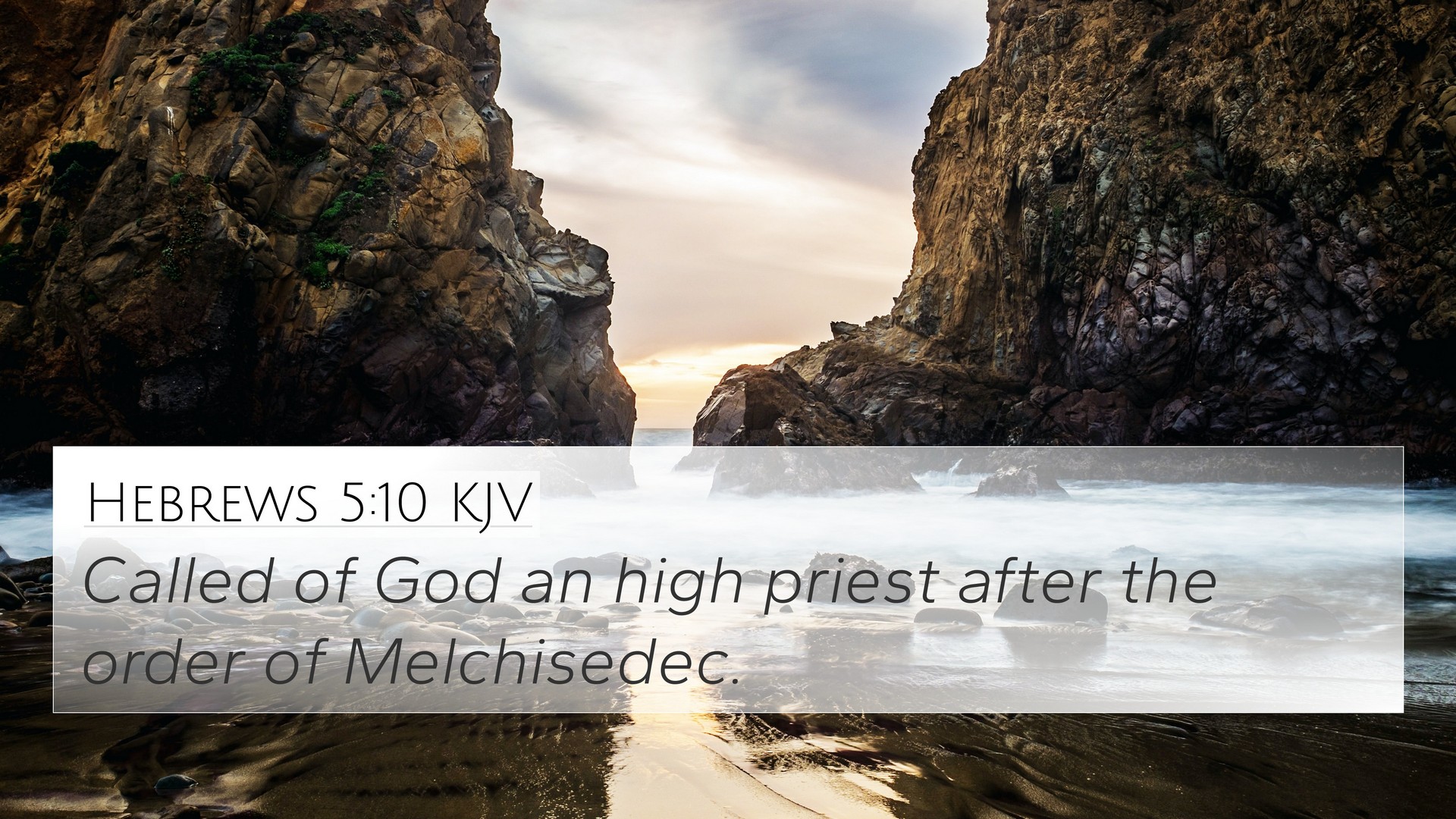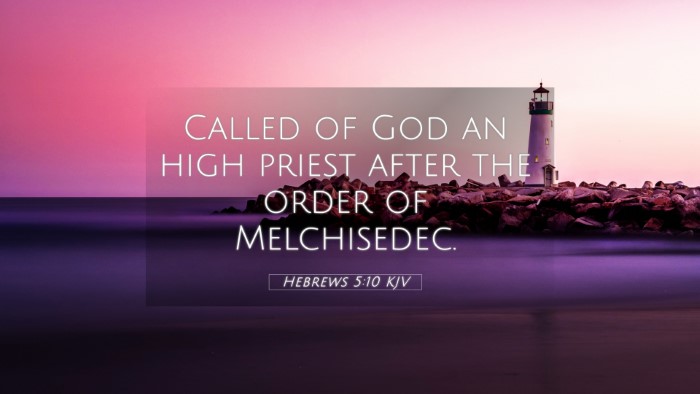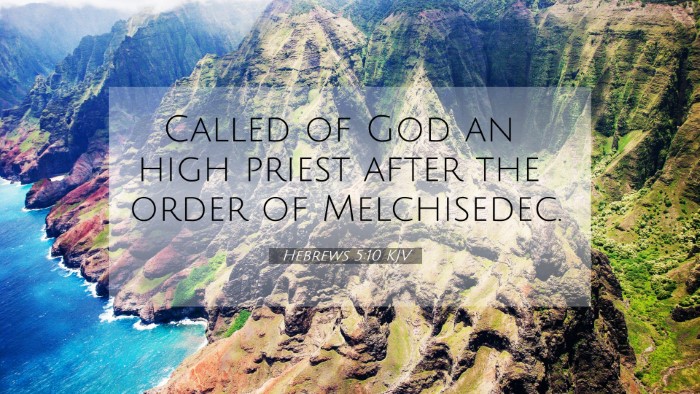Old Testament
Genesis Exodus Leviticus Numbers Deuteronomy Joshua Judges Ruth 1 Samuel 2 Samuel 1 Kings 2 Kings 1 Chronicles 2 Chronicles Ezra Nehemiah Esther Job Psalms Proverbs Ecclesiastes Song of Solomon Isaiah Jeremiah Lamentations Ezekiel Daniel Hosea Joel Amos Obadiah Jonah Micah Nahum Habakkuk Zephaniah Haggai Zechariah MalachiHebrews 5:10 Similar Verses
Hebrews 5:10 Cross References
Called of God an high priest after the order of Melchisedec.
Uncover the Rich Themes and Topics of This Bible Verse
Listed below are the Bible themes associated with Hebrews 5:10. We invite you to explore each theme to gain deeper insights into the Scriptures.
Hebrews 5:10 Cross Reference Verses
This section features a detailed cross-reference designed to enrich your understanding of the Scriptures. Below, you will find carefully selected verses that echo the themes and teachings related to Hebrews 5:10 KJV. Click on any image to explore detailed analyses of related Bible verses and uncover deeper theological insights.
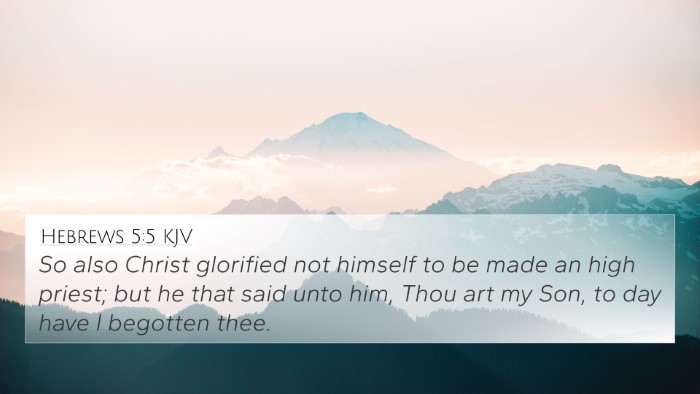
Hebrews 5:5 (KJV) »
So also Christ glorified not himself to be made an high priest; but he that said unto him, Thou art my Son, to day have I begotten thee.
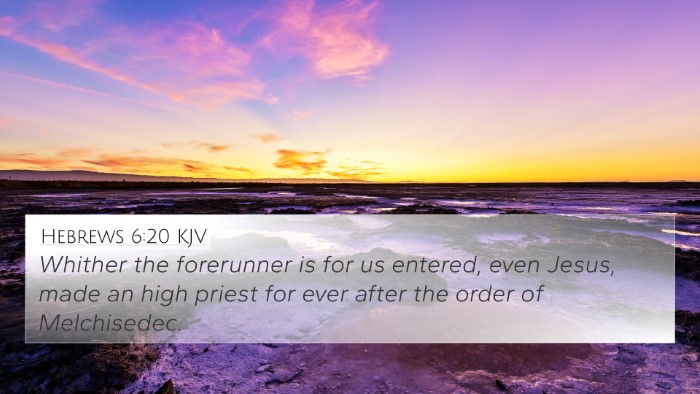
Hebrews 6:20 (KJV) »
Whither the forerunner is for us entered, even Jesus, made an high priest for ever after the order of Melchisedec.
Hebrews 5:10 Verse Analysis and Similar Verses
Understanding Hebrews 5:10
Hebrews 5:10 states, "Called of God an high priest after the order of Melchisedec." This verse holds significant theological implications, especially in regard to Christ's priesthood and its relation to the Old Testament. Let's explore various interpretations and meanings drawn from public domain commentaries.
Overview of the Verse
This verse highlights the divine appointment of Jesus Christ as a high priest, emphasizing His unique priestly order—Melchisedec. This is significant in understanding the comparison between Jesus and traditional Levitical priests.
Insights from Matthew Henry's Commentary
- Divine Appointment: Henry notes that Christ's priesthood is divinely ordained, contrasting with mere human qualifications.
- Order of Melchisedec: He highlights Melchisedec's unique status as both king and priest, establishing a type that foreshadows Christ's dual role.
- Call of God: Emphasis on the calling signifies that this role is in accordance with God's plan, rather than through lineage.
Insights from Albert Barnes' Commentary
- High Priesthood of Christ: Barnes elaborates on the superiority of Christ’s priesthood compared to the Aaronic line, highlighting the spiritual significance.
- Nature of Christ's Priesthood: He insists that the eternal and unchangeable nature of Christ's priesthood is crucial for believers' assurance.
- Typology of Melchisedec: He discusses how Melchisedec serves as a type of Christ, providing a lens through which to understand Jesus’ eternal priesthood.
Insights from Adam Clarke's Commentary
- Understanding Melchisedec: Clarke emphasizes the mystery surrounding Melchisedec and how it symbolizes Christ's eternal and unending priesthood.
- Significance of the Calling: He elaborates on the calling from God, underscoring the authenticity and holiness associated with Jesus' role as high priest.
Bible Cross-References
Hebrews 5:10 has several connections to other scripture verses that deepen its meaning:
- Genesis 14:18-20: The origin of Melchisedec as both king and priest.
- Psalm 110:4: A prophetic reference to God's oath regarding the order of Melchisedec.
- Hebrews 6:20: Establishing Jesus as our forerunner within the order of Melchisedec.
- Hebrews 7:1-3: A detailed description of Melchisedec and his significance.
- Exodus 28:1: The establishment of the Aaronic priesthood and its limitations as compared to Christ's role.
- Romans 8:34: Affirming Christ's intercessory role as our high priest.
- 1 Timothy 2:5: The singular role of Christ as mediator between God and man.
Comparative Analysis
Theologically, Hebrews 5:10 can be analyzed in light of various themes throughout the Bible:
- Inter-Biblical Dialogue: The relationship between Old Testament priesthood traditions and the New Testament understanding of Christ’s role.
- Thematic Connections: Theological themes of kingship and priesthood, evident in both the Old and New Testaments.
- Comparative Study: Analyzing the differences between the Levitical priesthood and Jesus’ eternal priesthood gives insight into God’s redemptive plan.
Conclusion
In summary, Hebrews 5:10 underscores the divine election of Jesus Christ as a high priest, modeled after Melchisedec. The combination of insights from various commentaries reveals the depth of meaning in this passage, supporting the themes of divine calling, eternal priesthood, and the interconnection of biblical narratives.
Further Study Tools
For those interested in diving deeper into cross-referencing Biblical texts, consider utilizing:
- Bible Concordance: A tool to locate verses and themes related to specific topics.
- Bible Cross-reference Guide: Comprehensive resources that assist in finding thematic connections across scriptures.
- Cross-reference Bible Study Methods: Techniques for discerning relationships and themes through scripture analysis.
